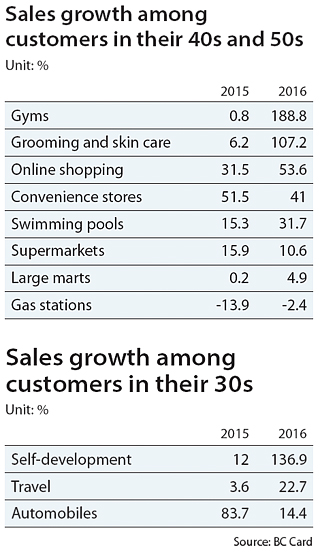Midlife buyers focus on beauty

Consumer trends have been shifting, with more active spending by “new normal middle age” consumers on areas related to self-development, according to a trend report by BC Card released on Tuesday.
The study analyzed spending by consumers in the last three years.
One of the biggest changes is middle-age consumer spending in areas like health clubs, which surged 188 percent, and swimming, which increased 31.7 percent. Their spending at gas stations has dropped 2.4 percent when compared to a year ago.
Other industries that also saw an uptick were grooming and beauty, including skin care and pets.
The way these consumers shop also has changed. Shopping at large discount stores like Lotte and E-Mart has dropped while spending at smaller and more tech-driven venues such as convenience stores and online shopping has risen.
Besides the “new normal middle age,” BC Card named four other major consumer trends for next year: early healing consumer; winner shopper; streaming shopper and navigation consumption.
Early healing consumers are those in their 30s who are focused on hobbies and wellness. In the last three years, people in their 30s have been increasing their spending on automobiles, health and golf. But spending on travel, including airline tickets, duty-free purchases and hotel booking has been steadily growing at a rate of 10 percent annually.
Winner shoppers have exceptional and somewhat obsessive hobbies, dubbed deokhu in Korean or ottaku in Japanese, that are more widely known globally. One of the common traits of such consumers is that they are extreme collectors of toy figures from popular culture, or are Trekkies.
Three years ago, deokhu were shunned as odd, but those consumers are now seen in a more positive light. Positive language associated with deokhu has risen 13 percent in the last three years while sales of toys and related items have risen 22 percent.
The consumers who purchase these items and toys are typically consumers in their 20s and those living alone.
Streaming shoppers enjoy communicating through videos and images rather than text messages, a rapidly growing consumer trend.
Navigation consumers use technology such as artificial intelligence, Internet of Things and location-based services as shopping tools, not only to save time but for convenience and lower prices.
“By analyzing the diverse social and culture areas, one can read the changing future and seize the opportunity,” said Kim Jin-cheol, head of the marketing strategy division at BC Card. “We plan to establish a differentiated strategy that could apply the consumer trends to our product development and marketing.”
BY LEE HO-JEONG [lee.hojeong@joongang.co.kr]










with the Korea JoongAng Daily
To write comments, please log in to one of the accounts.
Standards Board Policy (0/250자)